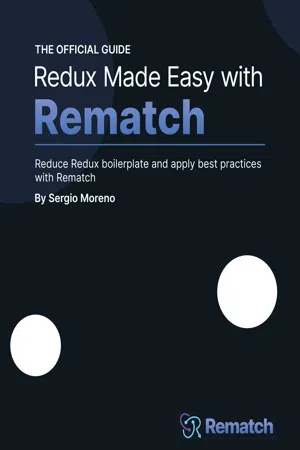
Redux Made Easy with Rematch
Reduce Redux boilerplate and apply best practices with Rematch
- 286 pages
- English
- ePUB (mobile friendly)
- Available on iOS & Android
Redux Made Easy with Rematch
Reduce Redux boilerplate and apply best practices with Rematch
About This Book
Discover the power of Rematch and its plugins by building a real-world application from scratch
Key Features
- Get to grips with the capabilities of Rematch quickly as you build applications
- Learn to use Rematch and its plugins to simplify everyday tasks
- Take total control of the application state and manage its scalability using Rematch
Book Description
Rematch is Redux best practices without the boilerplate. This book is an easy-to-read guide for anyone who wants to get started with Redux, and for those who are already using it and want to improve their codebase.
Complete with hands-on tutorials, projects, and self-assessment questions, this easy-to-follow guide will take you from the simplest through to the most complex layers of Rematch. You'll learn how to migrate from Redux, and write plugins to set up a fully tested store by integrating it with vanilla JavaScript, React, and React Native. You'll then build a real-world application from scratch with the power of Rematch and its plugins. As you advance, you'll see how plugins extend Rematch functionalities, understanding how they work and help to create a maintainable project. Finally, you'll analyze the future of Rematch and how the frontend ecosystem is becoming easier to use and maintain with alternatives to Redux.
By the end of this book, you'll be able to have total control of the application state and use Rematch to manage its scalability with simplicity.
What you will learn
- Understand the principal concepts of Flux and Redux
- Find out what the main problems are that Rematch solves
- Become familiar with the Rematch ecosystem
- Develop an application using Rematch and React together
- Write unit and integration tests to get 100% test coverage of your programs with Rematch
- Create a React Native app with Rematch and Expo
- Persist data with redux-persist and Rematch
- Build a Rematch plugin from scratch
Who this book is for
This book is for React and Redux users looking for better alternatives for Redux. Familiarity with JavaScript, React, and Redux will help you make the most of this book.
Frequently asked questions
Information
Section 1: Rematch Essentials
- Chapter 1, Why Redux? An Introduction to Redux Architecture
- Chapter 2, Why Rematch over Redux? An Introduction to Rematch Architecture
- Chapter 3, Redux First Steps – Creating a Simple To-Do App
- Chapter 4, From Redux to Rematch – Migrating a To-Do App to Rematch
Chapter 1: Why Redux? An Introduction to Redux Architecture
- Why Redux?
- What was there before Redux?
- How does Redux work?
Technical requirements
Why Redux?

- Manage large amounts of application state that are needed in many places.
- Manage business logic that is complex to update.
- Create an app that will be maintained by many people.
What was there before Redux?

Table of contents
- Redux Made Easy with Rematch
- Contributors
- Preface
- Section 1: Rematch Essentials
- Chapter 1: Why Redux? An Introduction to Redux Architecture
- Chapter 2: Why Rematch over Redux? An Introduction to Rematch Architecture
- Chapter 3: Redux First Steps – Creating a Simple To-Do App
- Chapter 4: From Redux to Rematch – Migrating a To-Do App to Rematch
- Section 2: Building Real-World Web Apps with Rematch
- Chapter 5: React with Rematch – The Best Couple – Part I
- Chapter 6: React with Rematch – The Best Couple – Part II
- Chapter 7: Introducing Testing to Rematch
- Chapter 8: The Rematch Plugins Ecosystem
- Section 3: Diving Deeper into Rematch
- Chapter 9: Composable Plugins – Create Your First Plugin
- Chapter 10: Rewrite a Full Code Base from JavaScript to TypeScript
- Chapter 11: Rematch with React Native and Expo – A Real-World Mobile App
- Chapter 12: Rematch Performance Improvements and Best Practices
- Chapter 13: Conclusion
- Other Books You May Enjoy